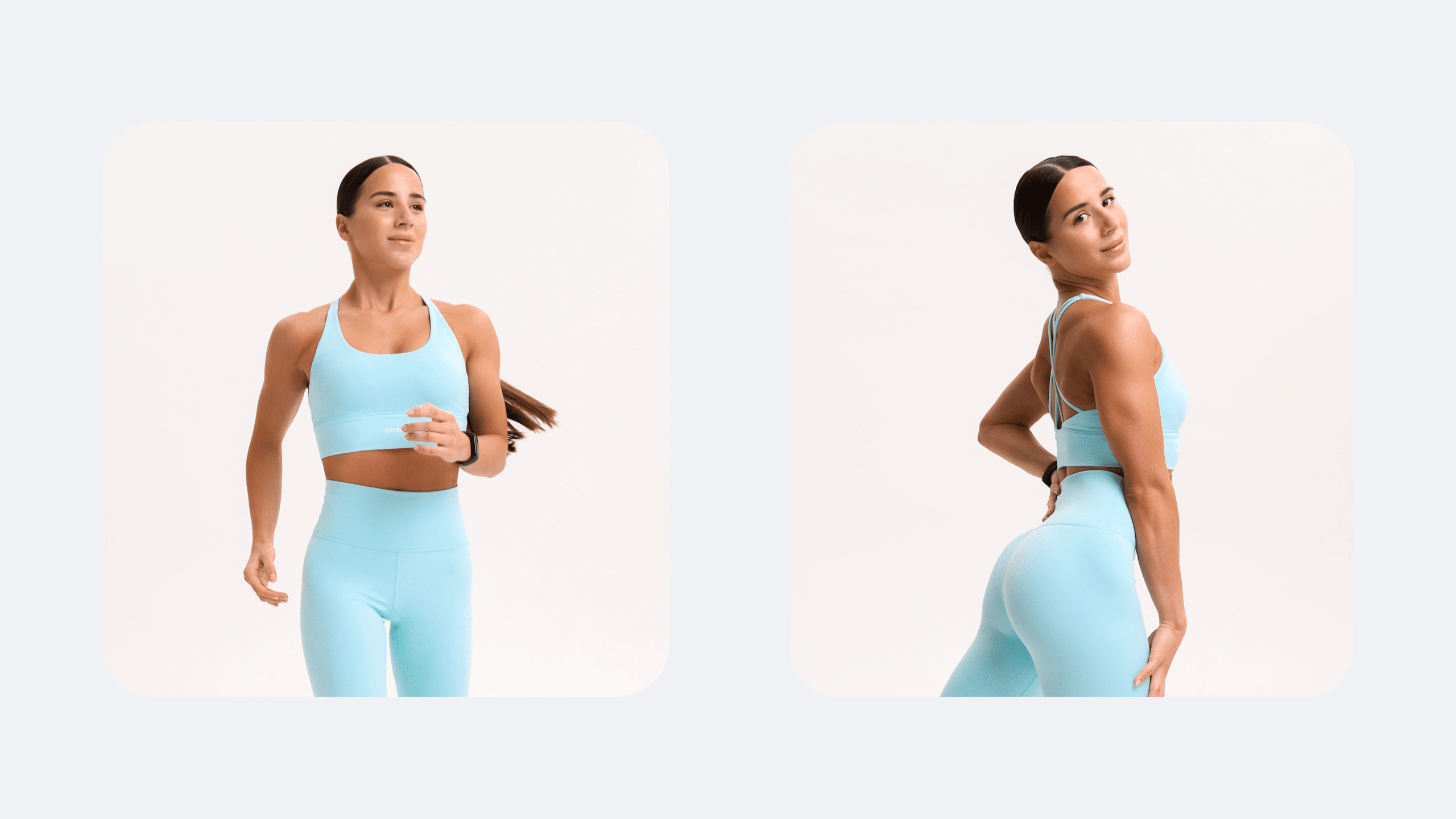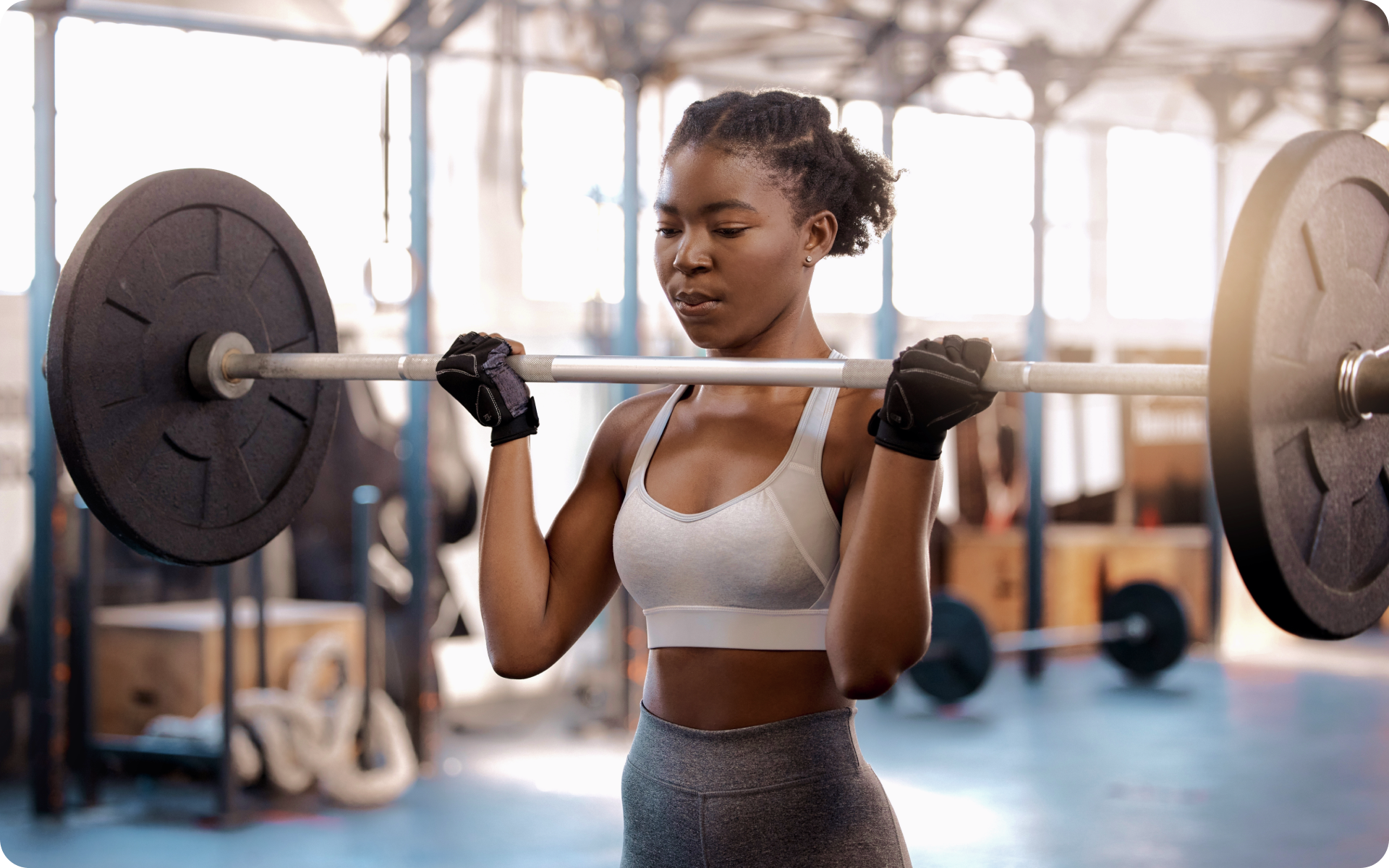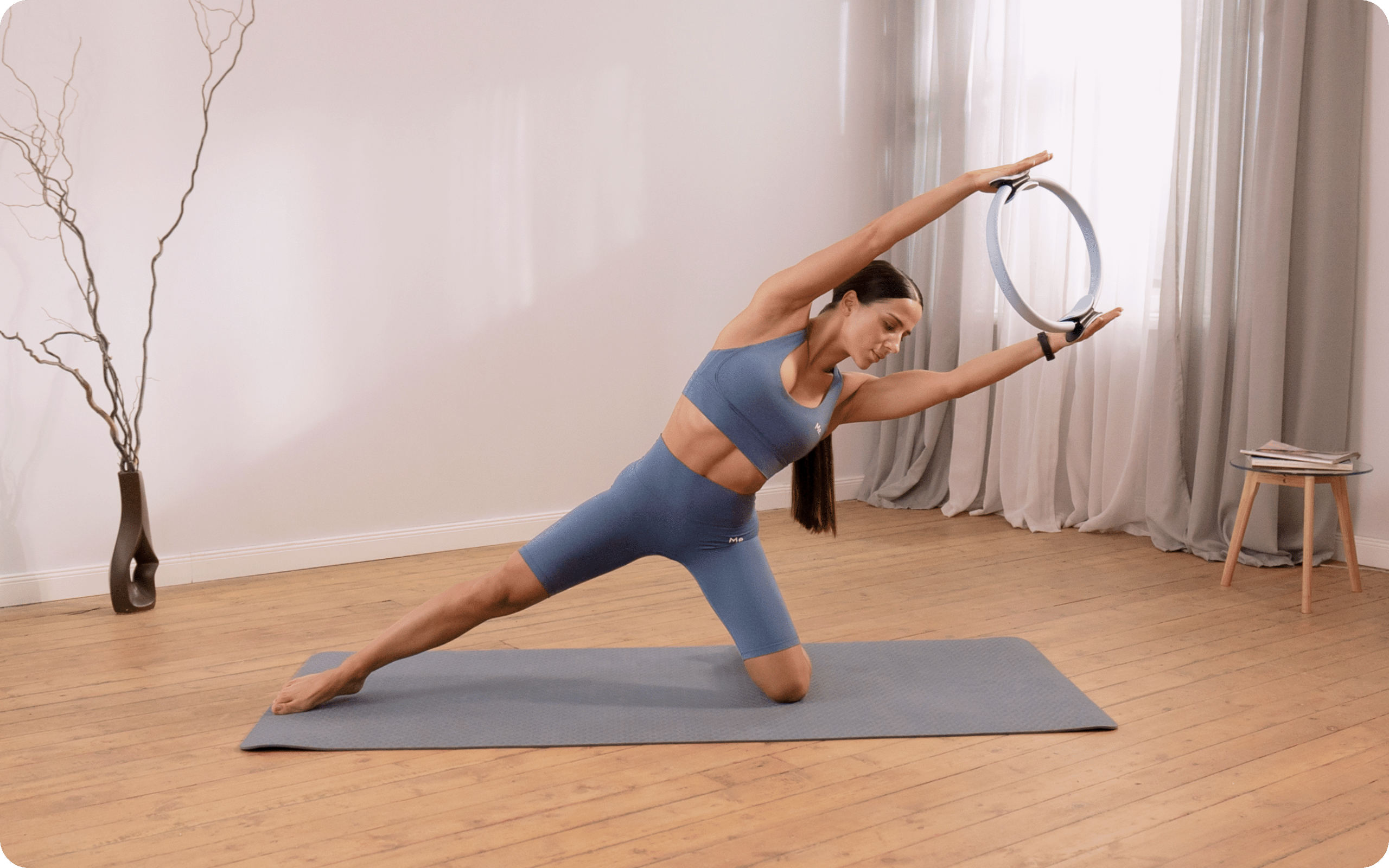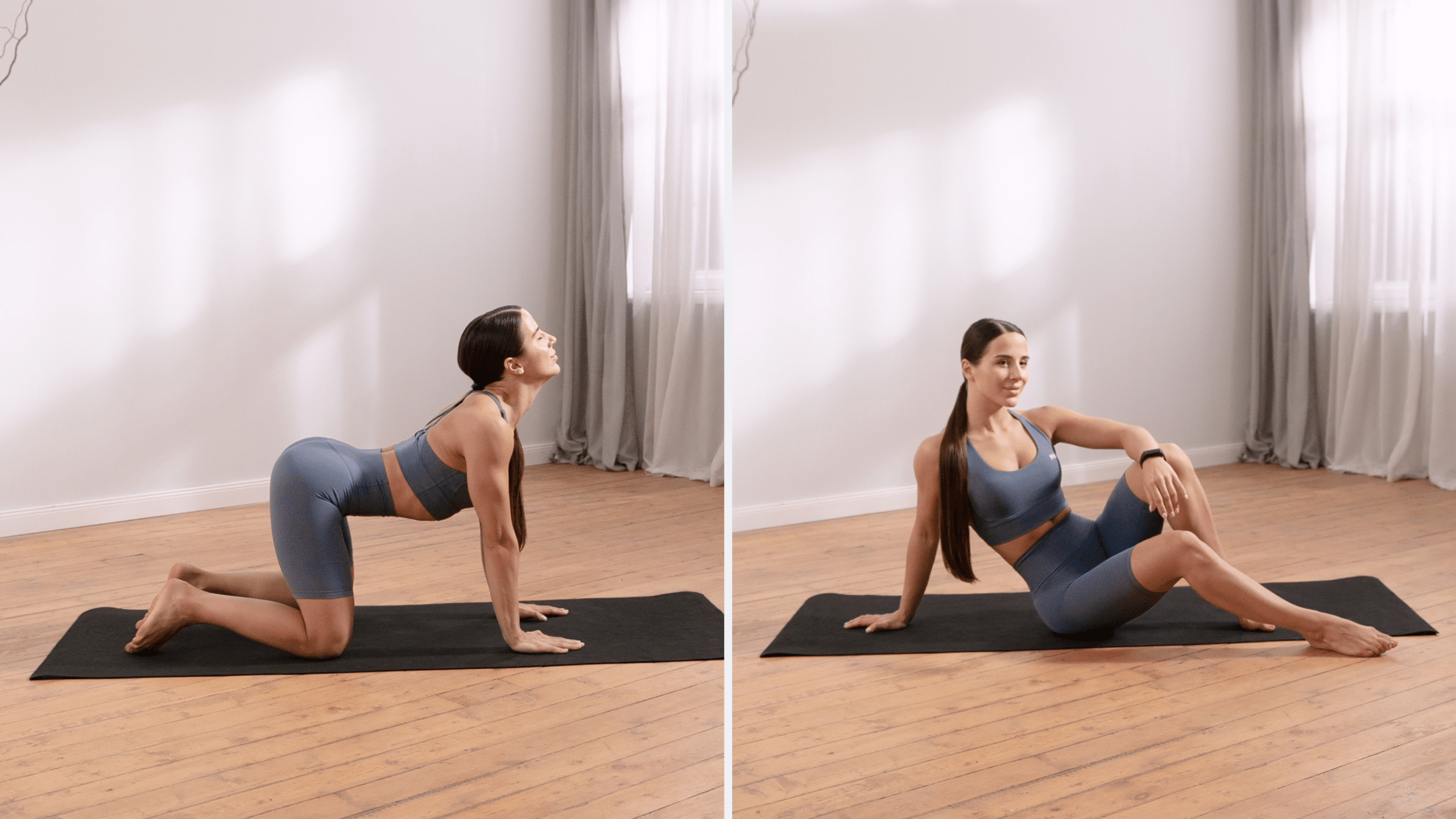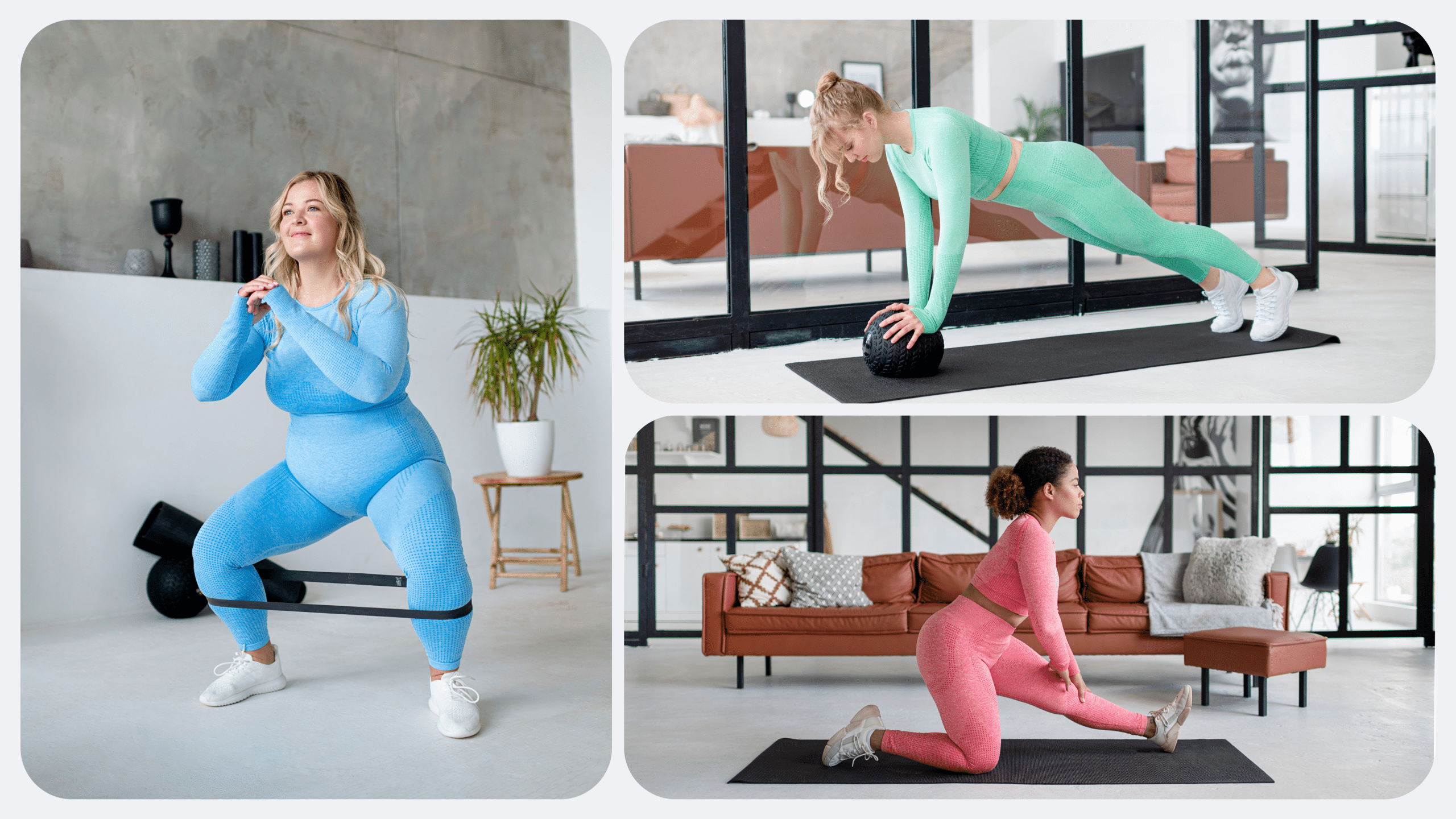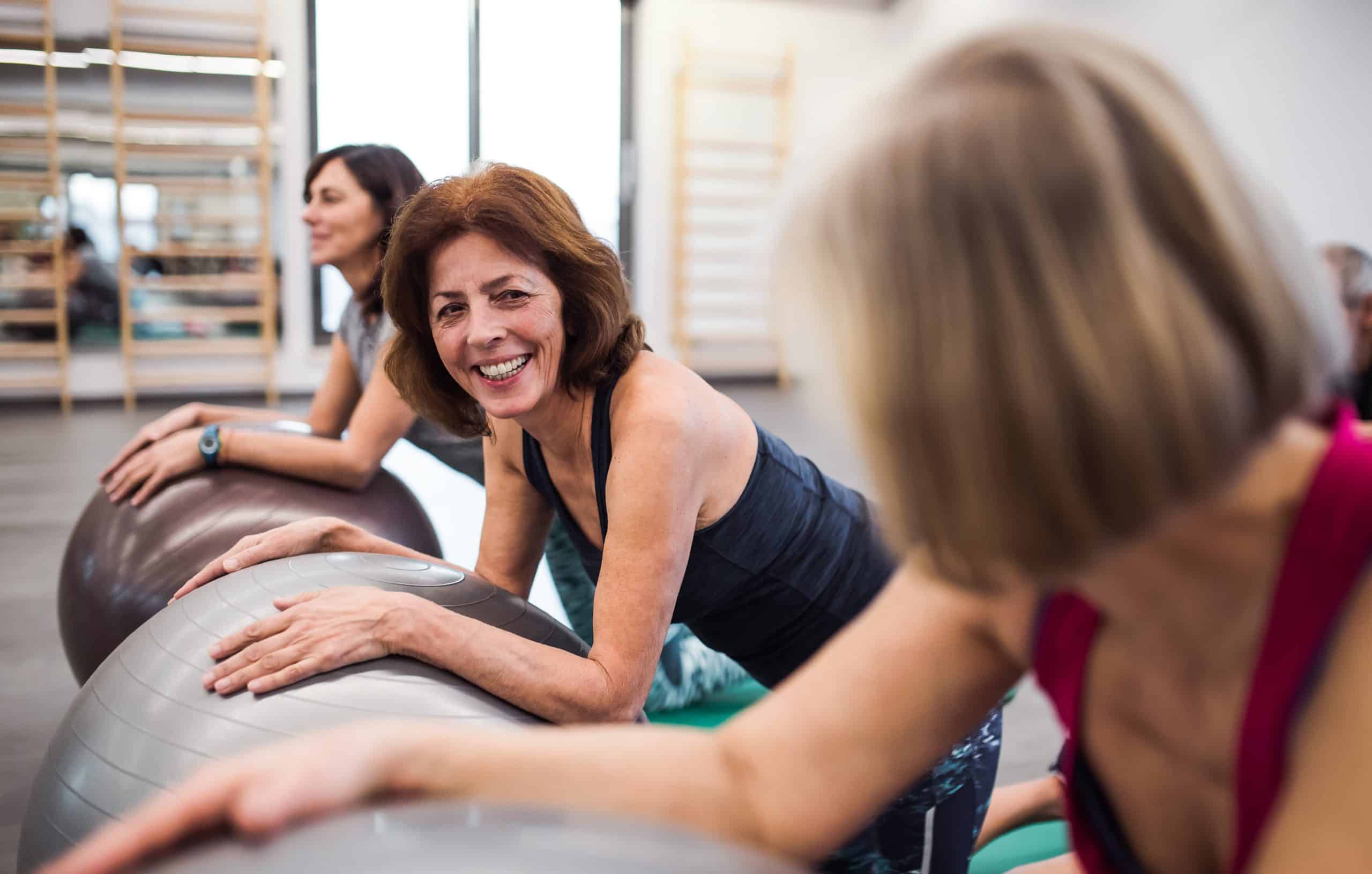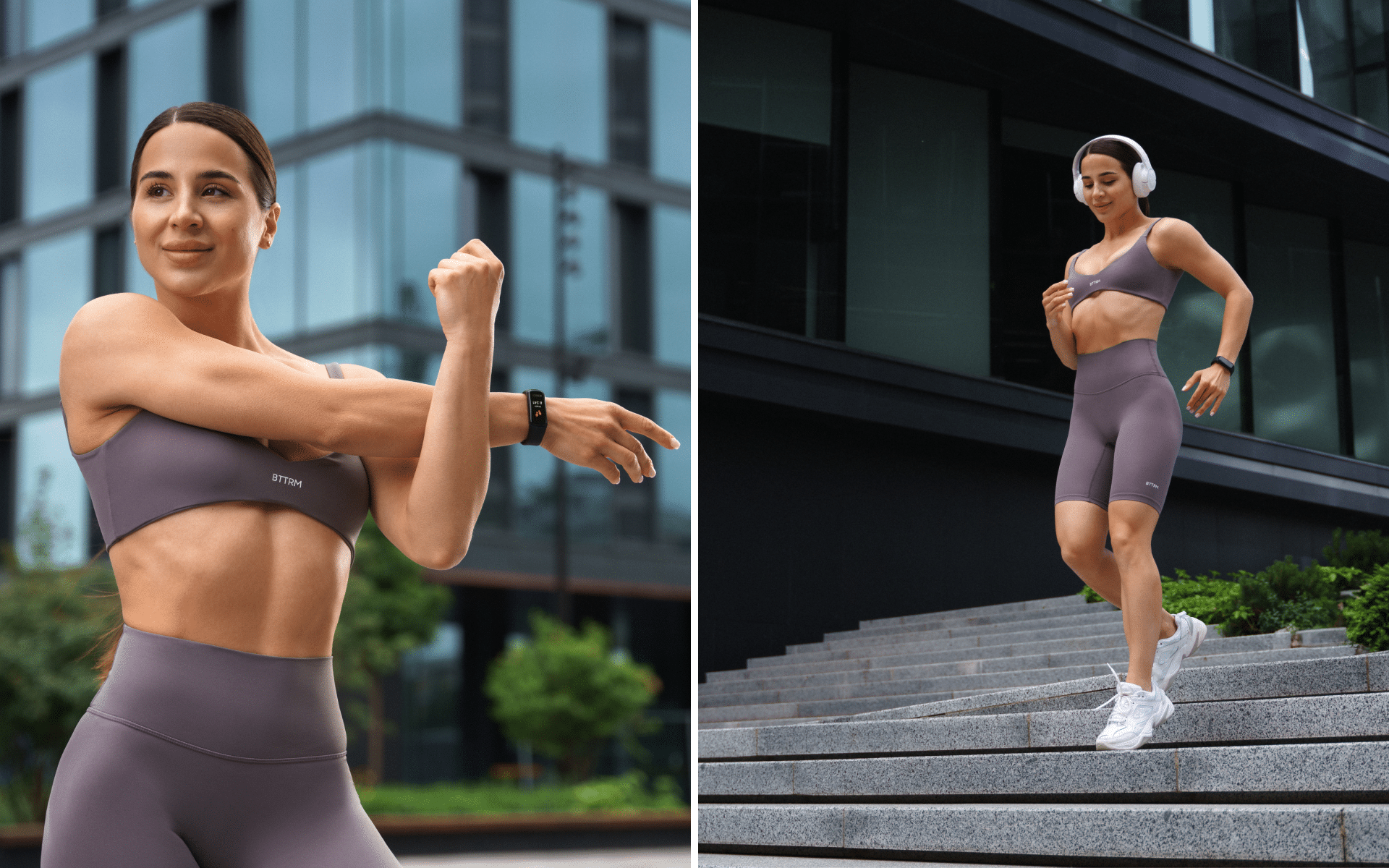Your butt muscles, aka glutes, are among the largest muscles in your body. These muscles perform a range of essential functions, from stabilizing your pelvis to propelling you forward and supporting your lower back. Your glutes are responsible for much of your strength and mobility (14).
Function aside, a well-shaped and toned backside is considered aesthetically pleasing. If you’ve seen how many “perky bum workouts” there are floating around on social media, you’ll know exactly what we mean.
So, when you start running, you may wonder; “Will running make my butt bigger?” “Will I get a toned, perky bum?” The answer is not as straightforward as you may think.
Will Running Make Your Butt Bigger?
Running, by itself, won’t necessarily make your butt bigger. This is because running primarily uses the muscles in the front of your legs, including your quads and calves, to propel you forward (18). However, this doesn’t mean that running has no impact on your glutes.
When you run, your glutes have to work to stabilize and support your body as it moves forward (18). This can help to strengthen your glutes and improve their overall appearance. In addition, running uphill or on an incline can engage your glutes more and potentially lead to some growth in muscle size.
Muscle growth, also known as hypertrophy, can occur in the glute muscles if (24):
- You engage in strength training exercises that specifically target your glutes
- You apply progressive overload, gradually increasing the weight or resistance used in your workouts
- You give your muscles enough rest and recovery time between workouts to allow for proper repair and growth
- You eat a balanced and nutritious diet that supports muscle growth (7)
The type of run also plays a role in whether or not your butt will get bigger.
Endurance running, where you primarily focus on maintaining a steady pace for longer distances, may not have as much of an effect on your glutes compared to sprinting or incorporating interval training. These types of runs require more explosive movements and can engage your glutes more intensely.
So, while running alone may not make your butt bigger, it can contribute to overall glute strength and potentially improve the appearance of your backside.
That being said, genetics also play a significant role in the size and shape of your glutes (2). Some individuals may naturally have a larger or more toned butt, while others may see less noticeable changes from running.
Does Running Tone Your Butt?
Yes, running can help tone your butt. “Toning” is a word that is often used to describe the appearance of a lean, defined muscle.
The extent to which your muscle definition is visible depends on your body fat percentage. If you have a higher percentage of body fat, your muscle definition may not be as apparent. Conversely, if you have a lower body fat percentage, your muscles will appear more defined.
Running is one of the most effective forms of cardio exercise, helping burn calories and reduce body fat. As you continue to run and maintain a healthy diet, your body fat percentage may decrease, which will allow for more visible muscle definition in your glutes.
Betterme will keep you laser-focused on your weight loss journey! Nutrient-packed meal plans, fat-blasting workouts, galvanizing challenges and much more. Try using the app and see for yourself!
Can Running Change Your Body Shape?
Absolutely. Running is quite the calorie-burner so you’ll definitely notice your body shape change for the better once you start. Here’s how:
Fat Reduction
Running is an effective way to burn calories, which can lead to a significant reduction in body fat (22).
When you run, particularly at a moderate to high-intensity, your body taps into stored fat for energy. Over time, this can lead to a leaner physique as excess fat, particularly that around the midsection, hips, and thighs, is burned off.
Muscle Tone
While running primarily engages the cardiovascular system, it also works various muscle groups, particularly in the lower body. The repetitive motion of running strengthens and tones muscles such as the quadriceps, hamstrings, calves, and glutes. This can result in firmer, more defined legs and a lifted appearance for the gluteal muscles.
Improved Posture
Running strengthens the core muscles, including the abdominals and lower back, which play an important role in maintaining good posture (26).
As your core becomes stronger, you may find yourself standing and sitting taller with a straighter back. Improved posture makes you look more confident and can also enhance the overall appearance of your body shape.
Enhanced Cardio Endurance
While this doesn’t directly change your physical shape, increased cardiovascular endurance from running can make other physical activities easier (4).
With improved stamina, you’re more likely to stay active and engage in various forms of exercise, which will contribute to a healthier and more toned body over time.
Increased Metabolism
Regular running boosts your metabolism, which means that your body continues burning calories even at rest. This elevated metabolic rate can help maintain a healthy weight and prevent fat accumulation (22).
A higher metabolism also supports muscle growth and repair, which helps with the development of a more sculpted physique (13).
Learn more about your body metabolism and weight loss and gain in our blog Resting Calories: What You Need to Know.
Lean Muscle Mass
Engaging in consistent running, particularly interval training or hill sprints, can help build lean muscle mass in some sections (21). While they’re not as significant as weightlifting, these types of running workouts stimulate muscle fibers and promote hypertrophy, leading to a more athletic and toned appearance.
Reduced Cellulite
Running can improve blood flow and circulation, which may help reduce the appearance of cellulite (5).
Enhanced circulation helps deliver nutrients to the skin and underlying tissues, potentially smoothing out those pesky dimples, particularly when combined with a well-balanced diet and adequate hydration.
Weight Loss
Overall weight loss is one of the most noticeable changes for many runners (22).
As you shed pounds through regular running, your body’s proportions will shift, often resulting in a slimmer waistline, reduced hip circumference, and a general decrease in body size. This comprehensive change can dramatically alter your body’s shape, making you feel lighter and more agile.
Read more: Intermittent Fasting and Running: A Winning Combination or a Terrible Mistake?
What Will Happen to Your Body if You Run Every Day?
If you run every day, there are several potential outcomes for your body:
Your Lung Capacity Will Increase
As you engage in regular running, your lungs adapt to supply your body with the necessary oxygen more efficiently (23). This adaptation involves several physiological changes.
Firstly, running improves the strength and endurance of the respiratory muscles, including the diaphragm and the intercostal muscles (15). These muscles play an important role in expanding and contracting your lungs, and as they become stronger, your lungs can take in more air with each breath.
Secondly, running boosts the efficiency of your alveoli, the tiny air sacs in your lungs where gas exchange occurs. With consistent aerobic exercise, the number of capillaries that surround each alveolus increases, facilitating a more effective exchange of oxygen and carbon dioxide (16).
One of the most immediate effects you’ll notice is the ability to take deeper breaths. This means more oxygen is delivered to your bloodstream, which enhances your stamina for other physical activities. Furthermore, your resting respiratory rate can decrease – your body doesn’t have to work as hard to meet its oxygen needs.
These adjustments can lead to a considerable improvement in your lung capacity over time.
This isn’t only beneficial for running; it can also positively impact various aspects of your daily life. Tasks that previously left you winded, such as climbing stairs or carrying heavy items, may become easier.
Your Lung Efficiency Will Improve
During aerobic exercise, the body produces more red blood cells to carry oxygen-rich blood from your lungs to other tissues. These extra red blood cells mean more oxygen can be delivered to your muscles and organs (17).
At the same time, aerobic exercise promotes the production of myoglobin, a protein that stores oxygen in your muscle cells and helps sustain energy during long-distance runs (1).
When you run every day, your body becomes more efficient at using oxygen. This can lead to significant improvements in your stamina and endurance.
Find out the pros and cons of running 10 Miles a Week and if this running distance will help you meet your fitness goals in our previous blog.
You’ll Burn More Calories
Running is an intense cardiovascular activity that fires up your metabolism, which helps you burn more calories than other forms of exercise. When you run every day, this calorie-burning effect is amplified.
As your body adapts to the increased energy demands of daily running, your resting metabolic rate may also increase. This means you’ll continue to burn more calories even when at rest.
Your Heart Will Become Stronger
Running is an excellent cardiovascular exercise that strengthens the heart muscle. When you run every day, your heart works harder to pump blood throughout your body, which increases its efficiency over time (3).
A stronger heart means better blood circulation, delivering more oxygen and nutrients to your muscles and organs. This adaptation can also lead to a lower resting heart rate, as your heart becomes more efficient at each beat.
A healthy heart and lifestyle reduces the risk of cardiovascular diseases, such as heart attacks and hypertension (12).
Your Muscles Will Adapt and Strengthen
Daily running leads to significant adaptations in your muscle fibers (8). Your muscles, particularly those in the lower body such as the calves, quadriceps, and hamstrings, become more resilient and stronger.
Muscle endurance also improves as the muscle fibers adapt to the repetitive motion and varying intensity of running. This not only enhances your running performance but also makes everyday activities less exhausting.
Over time, you may notice increased muscle definition and tone, contributing to a more athletic physique.
Your Bones Will Become Denser
Impact exercises such as running stimulate bone formation and contribute to increased bone density. When you run, the stress that is placed on your bones signals your body to strengthen them (9).
This can lead to healthier, denser bones over time, which reduces the risk of osteoporosis and fractures as you age (9). Running is particularly effective for building bone mass in the lower body—hips, legs, and spine—as these areas bear most of the impact.
Your Brain Will Function Better
Running every day has a profound impact on brain health. The increased blood flow provides more oxygen and nutrients, which enhances cognitive functions such as memory, focus, and problem-solving.
Furthermore, exercise such as running promotes the expression of brain-derived neurotrophic factor (BDNF), a protein that promotes the growth and survival of neurons. This can potentially reduce the risk of neurodegenerative diseases such as Alzheimer’s (10).
In addition, the endorphins that are released during running can improve your mood, reducing symptoms of depression and anxiety.
Your Immune System Will Get a Boost
Regular exercise such as running enhances the efficiency of your immune system. It increases the circulation of white blood cells and antibodies, which helps your body detect and fight off illnesses more effectively (19).
Running also promotes the release of cytokines, proteins that play a crucial role in immune response (20). This means that moderate daily running can make you less susceptible to common illnesses such as colds and infections.
However, it’s important to balance intensity and rest to avoid overtraining, which can temporarily weaken the immune system.
BetterMe app will kick you out of the mental funk, shake off your extra weight, rid you off your energy-zapping habits, and help you sculpt the body of your dreams. Intrigued? Hurry up and change your life for the better!
Your Skin Will Glow
Regular running promotes healthier skin by boosting blood circulation, which delivers more oxygen and nutrients to skin cells. This increased blood flow can give your skin a natural, healthy glow (25).
In addition, the reduction in stress levels from running can lead to fewer breakouts and an overall improvement in skin health (25).
Remember to stay hydrated and protect your skin from sun exposure to maximize these benefits.
Are you unsure which running distance is best suited for you? Find out how to determine the best mileage to match your fitness level and goals in our post How Many Miles Should I Run a Week?
FAQs
What causes increases in buttock size?
An increase in buttock size, or the appearance of a larger butt, can be caused by various factors such as weight gain, hormonal changes, and genetics. Performing exercises that target the gluteal muscles, such as running, may also contribute to a more prominent behind.
Let’s take a more in-depth look at the potential reasons for an increase in buttock size:
- Weight gain: Gaining weight can lead to an increase in fat cells throughout the body, including the buttock area. This can result in a larger appearance of the butt (6).
- Hormonal changes: Hormonal imbalances or fluctuations, such as during puberty or pregnancy, can result in a redistribution of fat to specific areas of the body, such as the buttocks (6) (11).
- Genetics: The shape and size of your butt are primarily determined by genetics (w). Some individuals may naturally have a larger butt due to their genes.
Muscle development: Doing exercises that target the gluteal muscles, such as running, can lead to muscle growth in the buttock area, resulting in a more prominent appearance (w)
What sports grow your glutes?
Sports that grow your glutes are those that require significant lower body strength, explosive movements, and repeated engagement of the gluteal muscles. Here are some sports that are known for growing glutes, supported by research:
- Track and Field Events: Sprinting, hurdling, and long jumping involve explosive movements and extensive use of the gluteus maximus and medius.
- Soccer: This sport requires constant running, quick changes in direction, and powerful kicks, all of which engage the gluteal muscles extensively.
- Baseball: Particularly pitching and hitting, which rely on strong lower-body muscles, including the glutes, to generate power and stability.
- Weightlifting: Specifically exercises such as squats, deadlifts, and hip thrusts prominently target the glutes for strength and hypertrophy.
- Cycling: Engages the glutes consistently, particularly during uphill climbs or sprinting phases, which require more power from the posterior chain.
Do squats make your butt bigger?
Squats can potentially contribute to an increase in buttock size due to muscle growth. When they’re done correctly with heavy weight and high volume, squats can help build strong and shapely glutes. They primarily target the gluteus maximus, the largest muscle in the butt (27).
However, genetics and overall diet play a significant role in determining how much your butt can grow from squats.
In addition, to see significant glute growth, it’s important to incorporate a variety of exercises that target all three gluteal muscles (maximus, medius, and minimus). Doing this will prevent muscular imbalances and ensure balanced growth in the buttock area.
How to decrease butt size?
If you’re looking to decrease your butt size, you may target overall fat loss through a combination of a healthy diet and regular cardiovascular exercise, such as running.
In this way, the portion of fat stored in the buttocks area will decrease, which will lead to a smaller butt. In addition, incorporating exercises that are focused on building lean muscle mass, such as squats and lunges, can help reduce excess fat and tone the gluteal muscles.
Your genetics play a significant role in determining where your body stores fat and spot reduction is not possible (6). Therefore, it’s important to maintain a balanced and healthy lifestyle to achieve overall fat loss (28).
The Bottom Line
Does running make your butt bigger? Not necessarily. However, running can significantly contribute to a shapelier and more toned behind, along with numerous other health benefits. Combining regular running with targeted strength training exercises can help you achieve your desired butt shape and size while improving your overall physical and mental well-being.
DISCLAIMER:
This article is intended for general informational purposes only and does not serve to address individual circumstances. It is not a substitute for professional advice or help and should not be relied on for making any kind of decision-making. Any action taken as a direct or indirect result of the information in this article is entirely at your own risk and is your sole responsibility.
BetterMe, its content staff, and its medical advisors accept no responsibility for inaccuracies, errors, misstatements, inconsistencies, or omissions and specifically disclaim any liability, loss or risk, personal, professional or otherwise, which may be incurred as a consequence, directly or indirectly, of the use and/or application of any content.
You should always seek the advice of your physician or other qualified health provider with any questions you may have regarding a medical condition or your specific situation. Never disregard professional medical advice or delay seeking it because of BetterMe content. If you suspect or think you may have a medical emergency, call your doctor.
SOURCES:
- Aerobic performance and the function of myoglobin in human skeletal muscle (2004, Journals.physiology.org)
- Are Perfect Glutes in Your DNA or Your Workout Routine? (2023, issaonline.com)
- Cardiovascular aspects of running (1985, pubmed.ncbi.nlm.nih.gov)
- Cardiovascular Endurance: What It Is, and How to Improve It (2024, webmd.com)
- Cellulite: What It Is, Causes & Treatment (2021, clevelandclinic.org)
- Determinants of body fat distribution in humans may provide insight about obesity-related health risks (2019, ncbi.nlm.nih.gov)
- Eat to Gain Muscle-The Role Food Plays in Strength Training (2024, issaonline.com) d
- Effect of speed endurance training and reduced training volume on running economy and single muscle fiber adaptations in trained runners (2018, onlinelibrary.wiley.com) e
- Exercise and Bone Health (2020, orthoinfo.aaos.org)
- Exercise promotes the expression of brain derived neurotrophic factor (BDNF) through the action of the ketone body β-hydroxybutyrate (2016, ncbi.nlm.nih.gov)
- Gestational potential space hypothesis: Evolutionary explanation of human females body fat redistribution (2021, academic.oup.com)
- Impact of Lifestyle Modifications on Cardiovascular Health: A Narrative Review (2023, ncbi.nlm.nih.gov)
- Increasing muscle mass to improve metabolism (2013, ncbi.nlm.nih.gov) j
- Muscles of the Gluteal Region – Superficial – Deep – TeachMeAnatomy (2024, teachmeanatomy.info)
- Practical Application of Respiratory Muscle Training in Endurance Sports (2024, journals.lww.com)
- Pulmonary Gas Exchange and Acid-Base Balance During Exercise (2021, ncbi.nlm.nih.gov)
- Red blood cells in sports: Effects of exercise and training on oxygen supply by red blood cells (2013, frontiersin.org)
- Running Biomechanics (n.d., physio-pedia.com)
- The compelling link between physical activity and the body’s defense system (2019, sciencedirect.com)
- The effect of exercise on cytokines: implications for musculoskeletal health: a narrative review (2022, biomedcentral.com)
- The Effect of High Intensity Interval Run Training on Cross-sectional Area of the Vastus Lateralis in Untrained College Students (2017, ncbi.nlm.nih.gov)
- The effect of regular running on body weight and fat tissue of individuals aged 18 to 65 (ncbi.nlm.nih.gov)
- The effects of place running exercises on the pulmonary function of normal adults (2017, ncbi.nlm.nih.gov)
- The Mechanisms of Muscle Hypertrophy and Their Application to Resistance Training (2010, journals.lww.com)
- The Potential of Exercise on Lifestyle and Skin Function: Narrative Review (2024, ncbi.nlm.nih.gov)
- The real-world benefits of strengthening your core (2012, health.harvard.edu)
- Understanding the Biomechanics of a Squat (2022, americansportandfitness.com)
- Weight loss – a healthy approach (2022, betterhealth.vic.gov.a)
